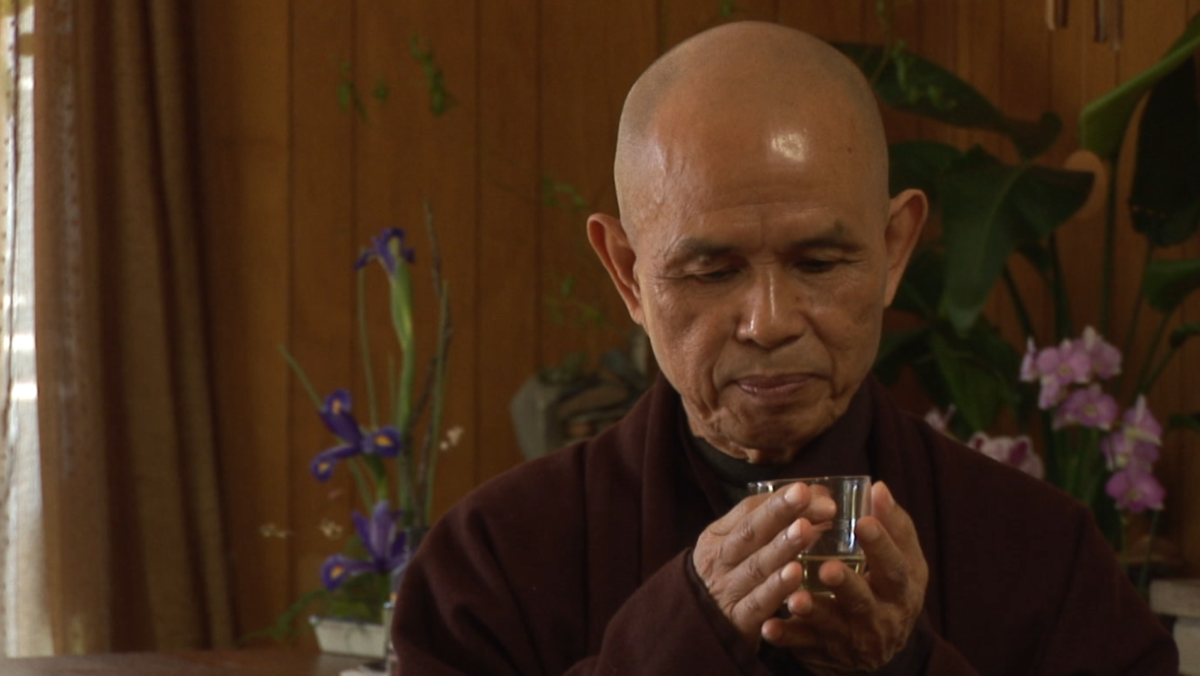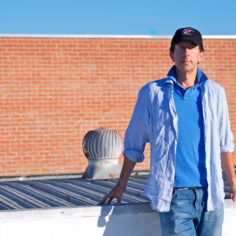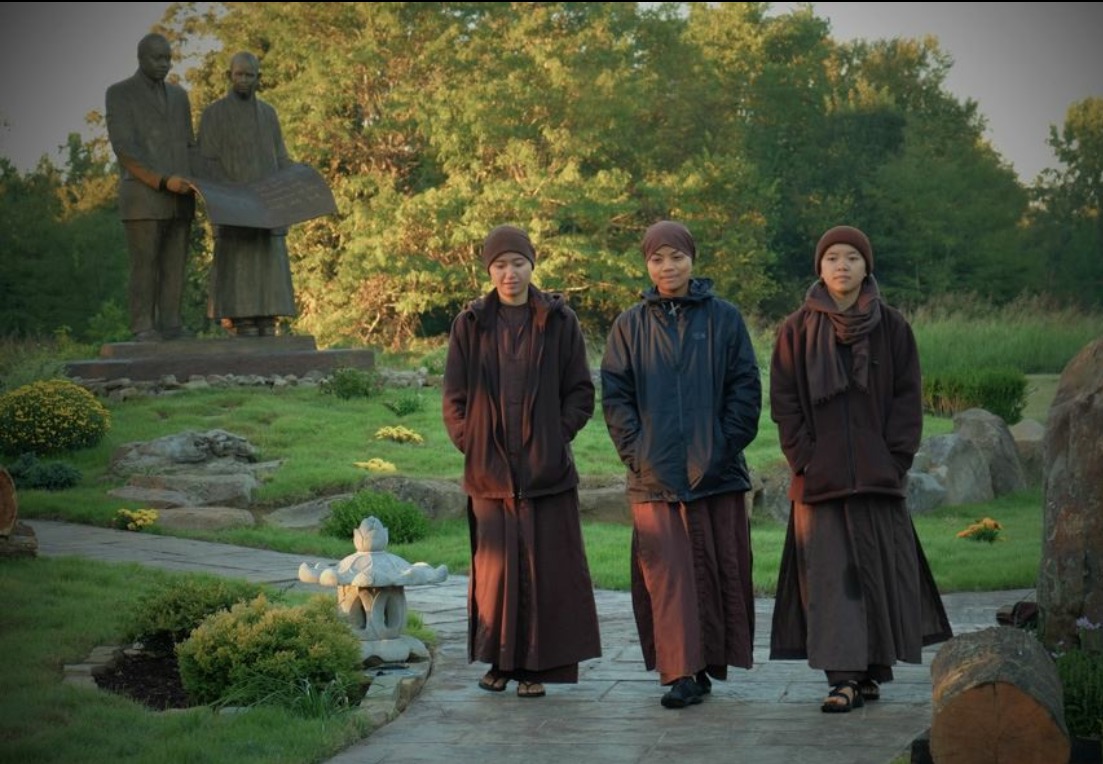By Larry Kasanoff in June 2016

I make movies about martial arts, science fiction, killer robots, funny cartoon characters, pretty girls—and I love it.
A Washington Post article about me started this way:
“… fights, explosions, mind-blowing visual effects and hot babes—this is Larry Kasanoff’s formula for success in the movie business.”
So how did I wind up friends with Thich Nhat Hanh,
By Larry Kasanoff in June 2016

I make movies about martial arts, science fiction, killer robots, funny cartoon characters, pretty girls—and I love it.
A Washington Post article about me started this way:
“… fights, explosions, mind-blowing visual effects and hot babes—this is Larry Kasanoff’s formula for success in the movie business.”
So how did I wind up friends with Thich Nhat Hanh, making a documentary titled Mindfulness: Be Happy Now?
Several years ago, I read Thay’s book Peace Is Every Step. I thought I could use his message as inspiration for a character in a series of movies I’ve made called Mortal Kombat. I arranged to meet him. After spending two hours with Thay and Sister Chan Khong and other monastics, I felt like I’d been on vacation for a week.
I asked Thay, “What is your secret?”
He said, “No secret—practice!”
I thought to myself, “Wow! Could I learn this?” In that moment, I became hooked on mindfulness.
Looking back, I realize that in addition to inspiration for my movie character, I probably was looking for something for myself. I’ve always loved what I do and I have tons of energy, but I also had a quick temper, didn’t listen well, multi-tasked too much, and had my share of anxiety.
Over the years, I saw Thay and Sister Chan Khong and Sister Dang Nghiem (Sister D)—whom I met along the way—as often as I could. They all came to my house once to speak to an invited group of Hollywood types, some of whom still tell me that night changed their lives.
I loved the times I spent with Thay and the sisters. We became, I like to think, good friends. I learned that Thay, in addition to being a Zen master, is also fun and has a great sense of humor. (People still need to realize mindfulness is fun!) I discovered that mindfulness was changing me. I gave out hundreds of Thay’s books, took anxiety-ridden girlfriends to meet Thay, and always talked about what I was learning to anyone who seemed remotely interested. I kept practicing as much as I could.
MAKE THE MOVIES MINDFULLY
One day, Thay asked me to make a documentary about mindfulness. He was very clear that it should not be about him but about teaching mindfulness. I’d never made a documentary and had no real interest in doing so, but I loved Thay’s message, “Peace in yourself, peace in the world.” What could be better than trying to spread this message? I loved Thay, so I agreed.
Thay first told me, “Make this movie mindfully.” Movies are made in many ways, including screaming, cajoling, arguing, working insane hours, and traveling like crazy. I’d never really experienced mindfully making a movie.
Once, while we were filming Thay and other monks on a really hot day when everyone was tired, the cameras broke. I worried the monks would call it quits or get upset about waiting for the cameras to be fixed and then we would need to shoot all over again. But as we were waiting, Thay said, “This is a wonderful moment. Let’s enjoy it.” If only all movies could be made this way!
In filmmaking, part of the process involves selling the film and including elements that will attract an audience. At one point, as I was raising money, I decided to add supermodels, sports stars, and martial artists to attract a broad audience. They all practiced mindfulness, so it was authentic.
I believe Thay understood, but it caused a stir in what I call the monk community. Most hated the idea. Had it not been a movie about mindfulness, I would’ve reacted by saying, “Tough—it’s my movie, I’m right, you’re wrong. We’re doing it this way and if you want to fight, I’ll use the controversy against you to sell the movie.” But then I thought of Thay’s words, “Make the movie mindfully.”
One of my favorite Thay-isms is, “Be still and know.”
I allowed myself to get still and realized that making this documentary was not like making my other movies. I realized that I was not the voice but the conduit and the presenter of the voices. So, for the first time in my life in movies, I axed the supermodels and ninjas. My decision made it nearly impossible to raise money, so I decided to finance the movie myself. Again I thought, “What could be better, as a charitable cause, than to spread the message, ‘Peace in yourself, peace in the world?’”
Over time, we attracted wonderful, brilliant, and famous practitioners of mindfulness from all walks of life. In addition to Thay, Sister Chan Khong, and Sister D, the documentary features Deepak Chopra, Academy Award-winning film director Oliver Stone, TV star and “dog whisperer” Cesar Milan, Harvard professor Dr. Blaise Aguirre, and actress Sharon Stone.
A ZEN-LIKE FILM
I discovered two things as I edited the interview footage. First, spending several hours a day watching and listening to the interviews made me so relaxed and mindful! Just their words had this effect, so I knew we were on to something. Second, any B-roll footage (supplemental footage alternating with the main shot) of people doing things like teaching, walking, or traveling would distract the audience from the great words our teachers spoke.
I decided that if we weren’t going to include the supermodels, we should just have the substance of mindfulness. Nothing else. No flashy shots, no animation, no visual effects. A Zen-like film about Zen.
We had so many great people saying so many thought-provoking, inspiring, mindful things, I decided we would just have the interviews. My goal became to make the movie not for those already deep in mindfulness practice, but for those searching, wanting to learn, needing just the right introduction to start their own process of discovery. Planting the seeds, as Sister D called it. I think people all over the world are searching for this; however, many aren’t sure where to start.
The film was released in November 2015 on Video on Demand (an Internet-based on-demand viewing platform provided by services like Apple’s iTunes, Amazon Prime, and Hulu). To my surprise, the distributors did no marketing, and neither did the monks. Sister Chan Khong did ask if there was a Hollywood premier she should attend (see, everyone gets a little affected by Hollywood!).
Once again, Thay’s words came back to me: Make the movie mindfully. It would have been kind of ironic to scream about a movie about mindfulness. Funny, but ironic. So I hired a great publicist.
Then a funny thing started to happen. People began finding the film, and they loved it. In my career, I’ve made more than two hundred movies. Family members and friends who’ve probably never called me about any of my other movies called and said they loved it. They said it was excellent. They recommended it to others. People we didn’t know called, wrote, and asked for screenings. Reporters seemed genuinely interested, not only for their readers but for themselves.
What do I feel about all this? Mostly I feel gratitude. I’m grateful for all the wonderful people I’ve met, with whom I’ve become friends and from whom I’ve learned so much. I’m grateful I can share what I’ve learned with people by simply pointing them to the film. I’m grateful that now I rarely get mad. I don’t multi-task anymore; I uni-task. I “get still and know” often, and have very little if any anxiety.
Dr. Aguirre told me someone called him and said the film made them cry with joy, as mindfulness helped save one of their children. He said to me, “If that’s all the film did, just for this one person, it would be worth it.” I’m grateful for that.
I still make action and science fiction movies full of supermodels and ninjas, and I love it more than ever. But now I always hear Thay’s words in my soul, not just about our documentary but about all my movies: “Make the movie mindfully.” So hopefully, I now do!
Mindfulness: Be Happy Now is available on Hulu, Xbox, Amazon, iTunes, and other Video on Demand services. For more information, visit mindfulnessthemovie.com.


